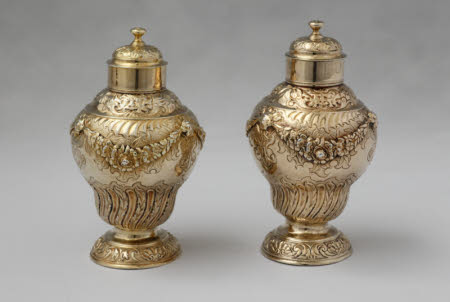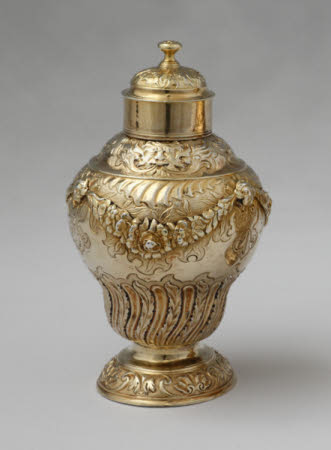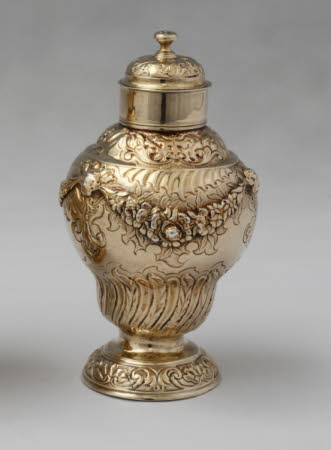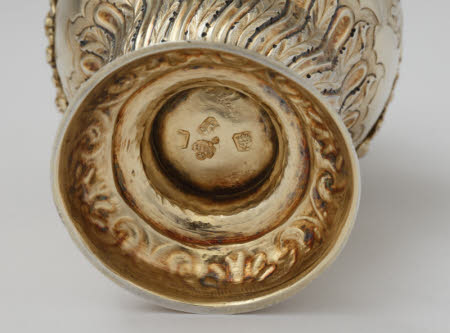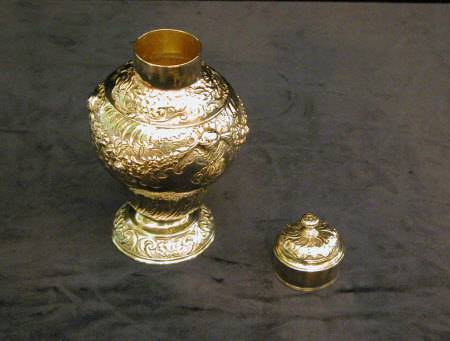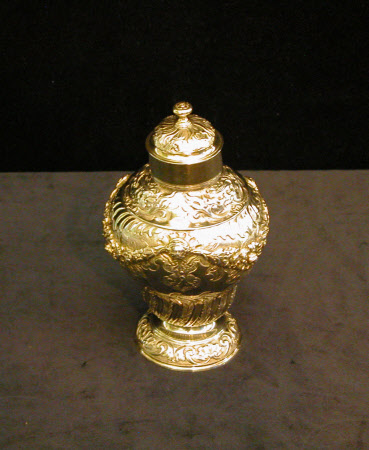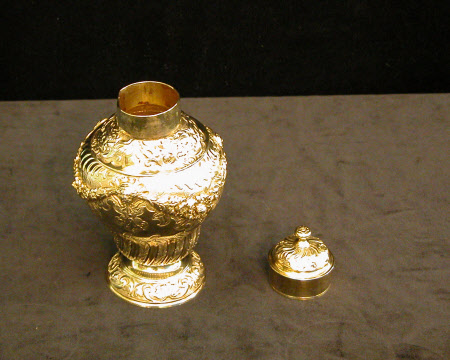Pair of tea canisters
Christian Hillan (fl. 1736-41), goldsmith
Category
Silver
Date
1738 - 1739
Materials
Silver-gilt, sterling
Measurements
15.9 cm (Height); 9.2 cm (Diameter)
Place of origin
London
Order this imageCollection
Ickworth, Suffolk
NT 852066
Summary
Pair of tea canisters, silver-gilt, by Christian Hillan, London, Sterling, 1738/9. The inverted pear-shaped bodies are raised and have cast floral swags hung from bearded and behatted masks on matted grounds with chased additional foliage, shells and husks. Below are swirling flutes and attenuated palm leaves, alternating, and above is ruffling, all being chased. The raised and applied domed shoulders are chased with grotesque masks breathing fire and the necks, over which the lids fit, are seamed and applied. The plain sleeve necks of the lids are seamed, and capped by raised domes with foliate chasing perhaps intended to represent steam. The knop finials are cast and chased on top with a stylised flower. Bands of chased shells and foliate strapwork on matted grounds decorate the cast feet. Heraldry and scratchweights: none. Hallmarks: Both are fully marked on the underside with date letter ‘C’, leopard’s head, lion passant and maker’s mark ‘CH’ with a pellet below and a leaf above (Arthur Grimwade, London Goldsmiths 1697-1837, 1990, no. 326).
Full description
In spite of being active for less than a decade after entering his first mark in 1736, Christian Hillan produced a relatively wide range of wares and seems to have had a significant output. It is, however, his fantastical decorative style, particularly on tea silver, that marks him out; quite unlike anything being produced at the time and in some elements almost reminiscent of the Renaissance. In addition to being a highly skilled chaser, he clearly had a vivid imagination and a wide range of sources and although he produced many tea canisters of the same basic form as these, no two pairs are exactly the same.[1] His distinctiveness could be the result of a Scandinavian origin, suggested by Arthur Grimwade.[2] Though joyous, his schemes of decoration are not always entirely coherent, but in the case of these canisters he has produced something very successful, and also playful, with the allusion to boiling water in the splendid fire-breathing grotesque masks chased beneath the necks. Others of his works in public collections, similarly exuberant in their decoration, include a covered jug, also of 1738, in the Museum of Fine Arts, Boston and a cream boat in the Ashmolean Museum, the purpose of the latter alluded by the cow and calf in its chased decoration.[3] Pairs of tea canisters were often sold with covered sugar boxes and contained in an exotic wood casket with silver mounts.[4] Most of the other elements of the tea equipage could also be provided in silver – tea spoons, sugar tongs, strainer spoons, slop basins, tea pots plus waiters to place them on, tea kettles, cream ewers and, to contain the whole ensemble other than the kettle, large salvers or tables. All these pieces appear in the ledgers of George Wickes, provided individually or in groups such as that supplied to Mrs Fellowes in March, 1736: To a tea pott & waiter Carved 19[oz]-9[dwt] [at] 8[s]/ £7-16 To Handle & graving £0-10-0 To six TeaSpoons Tongs & Strainer 3[oz]-4[dwt] £2 To a fluted Cream boat 5[oz]-8[dwt] £2-16 To a Slop Bason 11[oz]-3[dwt] [at] 7/6 £4-3 To a Sugardish & cover 11[oz]-2[dwt] [at] 7/6 £4-3 To graving 4 Coats [of arms] £0-10-0 [5] It seems, however, that silver did not dominate at Ickworth and St James’s Square in the eighteenth century, beyond the tea kettle (NT 852071), tea tables (NT 852116) and tea spoons. In the time of the 1st Earl all the other items may well have been in Oriental porcelain, numerous purchases being recorded in his accounts in the decades around 1700. The 2nd Earl added substantial quantities of Meissen, Chelsea and Sèvres including tea pots and stands, sugar dishes, slop basins and cream and milk pots.[6] As no porcelain canisters are listed those by Hillan must have been used alongside such pieces as the Sèvres tea cups and saucers ‘Elegantly Enamelled with flowers and richly finish’d in burnish’d Gold’. [7] In that context it makes sense that the canisters are not plain silver, though the current gilding is later as there is significant wear beneath its surface. The canisters were, for some reason, omitted from the 1811 plate list but that must have been a mistake as they appear in the next reckoning, drawn up on 15 April 1826, and are not noted as being additions. James Rothwell, Decorative Arts Curator January 2021 [Adapted from James Rothwell, Silver for Entertaining: The Ickworth Collection, London 2017, cat. 20, pp. 97-8.] Notes: [1] See, for instance the pairs sold at Sotheby’s, 26 February 1981, lot 179 and 14 March 1996, lot 147. They and the Ickworth pair share the cast swags hung from masks but the chasing varies significantly. [2] Arthur Grimwade, London Goldsmiths 1697-1837, 1990, p. 546. [3] Christopher Hartop, The Huguenot Legacy: English Silver 1680-1760, 1996, cat. 73, pp. 304-5 and Timothy Schroder, British and Continental Gold and Silver in the Ashmolean Museum, 2009, cat. 148, pp. 384-5. [4] See for instance that in the Ashmolean Museum, Schroder 2009 (see note 3), cats. 305, pp. 794-5. The caskets might also contain other elements of the equipage such as tea spoons and slop basins. [5] National Art Library, Garrard Ledgers, VAM 1 1735–40, f. 19, 20 March 1736. Mrs Fellows was probably Mary Martin, widow of the enormously wealthy merchant, William Fellowes of Eggesford in Devon. [6] Suffolk Record Office, 941/46/13, the 1st Earl of Bristol's diary and disbursements 1688–1742 and The National Archives, C 103/174 Hervey – v – Bristol 1762–79, ‘An Inventory of the Rt. Honble the Earl of Bristol’s China taken in St. James’s Square ye eighteenth July 1765’. See Patricia Ferguson, 'Digby, Tollemache and Hervey: three aristocrats and their ceramics', English Ceramic Circle Transactions, vol. 22 (2011), pp. 49-87 for a comprehensive analysis of the evidence for Lord Bristol’s porcelain. [7] The National Archives, C 103/174 Hervey – v – Bristol 1762–79, ‘An Inventory of China belonging to the Earl of Bristol – taken the 5th day of May 1775’.
Provenance
Probably John, Lord Hervey; by descent to the 4th Marquess of Bristol; accepted by the Treasury in lieu of death duties in 1956 and transferred to the National Trust.
Credit line
Ickworth, the Bristol Collection (National Trust)
Makers and roles
Christian Hillan (fl. 1736-41), goldsmith, goldsmith
